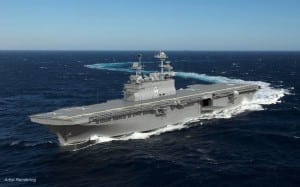The Government Accountability Office (GAO) last week said the Navy told it the Enterprise Air Surveillance Radar (EASR) is the biggest program risk to the future USS Bougainville (LHA-8) amphibious assault ship program.
LHA-8 will have “significant” design changes from previous ships in the class, but its use of the EASR system is a particular focus of the GAO’s annual Defense Acquisition Annual Assessment, published June 3.

GAO said while the LHA-8 program office did not identify any critical technologies with the ship, it identified its reliance on the EASR as “the program’s highest development risk.”
EASR is the latest version of the Navy’s SPY-6 family of radars to support anti-air and anti-surface warfare and the first system will be installed on LHA-8 before later being put on the future USS John F. Kennedy (CVN-79) Ford-class carrier. EASR will replace the N/SPS-48G air search radar on the USS America (LHA-6) and USS Tripoli (LHA-7).
The Navy plans to have the EASR delivered by contractor Raytheon Technologies [RTX] in August 2021, but the report warned modifications to accommodate the radar could push back the ship’s overall delivery date.
The report noted Navy officials said “during EASR development, they found that the mast blocked EASR’s field of view. They said that to reduce the obstruction and electromagnetic interference from EASR, they have to reconfigure the mast and nearby antennas, which may affect the ship’s planned delivery date of January 2024.”
GAO said the Navy plans to test the EASR-mast-antenna configuration in a laboratory environment to determine the impact of EAR before ship delivery.
The report also noted the LHA-8 program has encountered other construction challenges that increase schedule risk.
Notably, the subcontractor manufacturing the ship’s Main Reduction Gears (MRG) encountered quality issues that delayed delivery.
“Officials report that the contractor had been following a more aggressive construction schedule for ship delivery, but that the delay to the MRGs pushed them back to the contract’s schedule.”
GAO included Navy comments that Bougainville is “progressing well” and as of March was 12 percent complete.
It added “officials stated that the Navy has reduced risk in the topside design changes and finalized them with the contractor, and that EASR remains a development risk that the Navy is managing closely.”
The Navy awarded shipbuilder Huntington Ingalls Industries [HII a $3 billion contract modification to build LHA-8 in 2017 (Defense Daily, June 19, 2017).
The company started fabrication in October 2018 at its shipyard in Pascagoula, Miss. (Defense Daily, Oct. 16, 2018).
The ship is scheduled to launch in June 2022, undergo acceptance trials November 2023, and be delivered in January 2024. Construction started in October 2018.
Bougainville is designed to provide enhanced aviation capabilities to accommodate F-35Bs and MV-22 Ospreys, a well deck to accommodate two landing craft, and transport 1,350 Marines and their equipment to hostile shores.